Tan S.T. Finite Mathematics for the Managerial, Life, and Social Sciences
Подождите немного. Документ загружается.

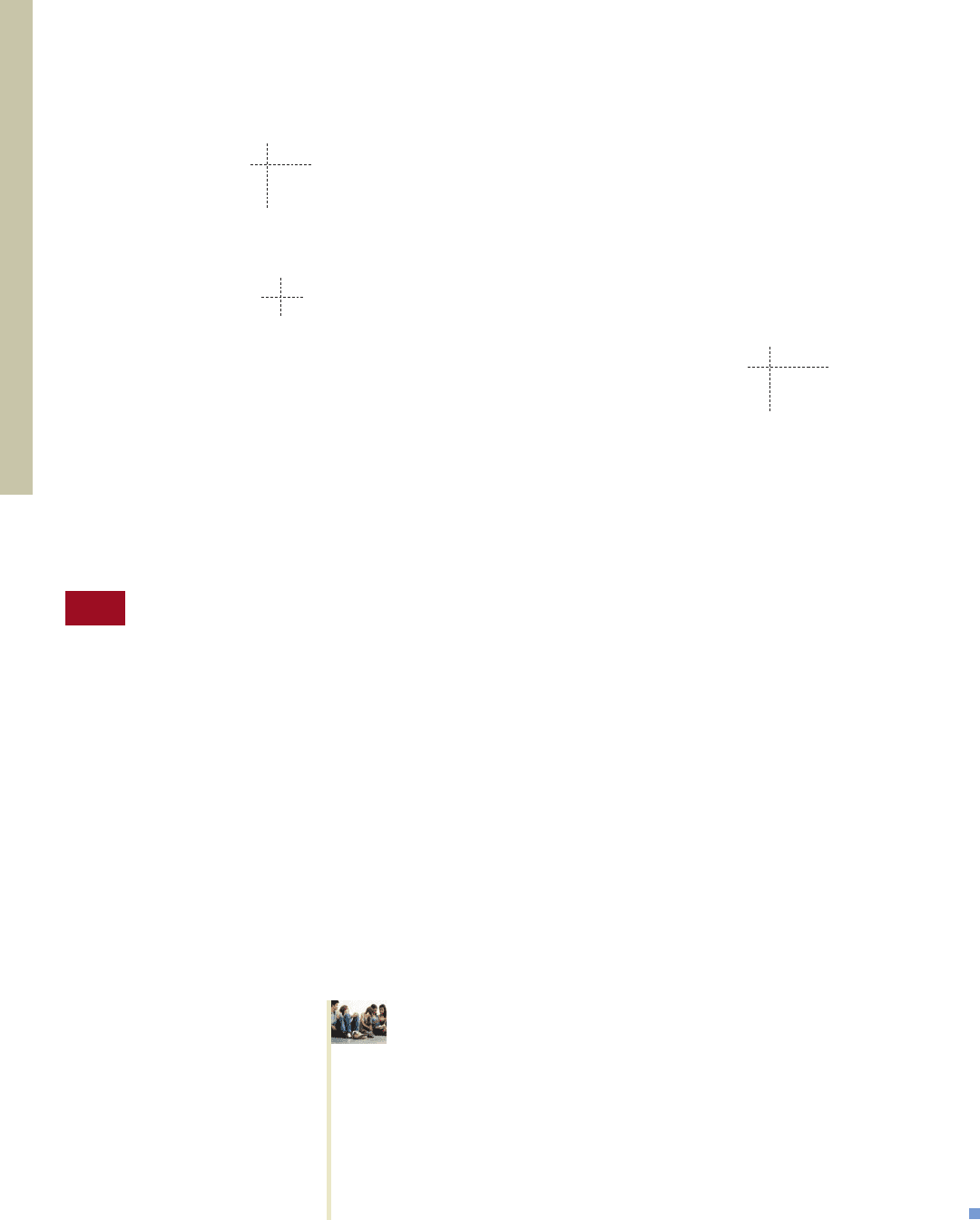
Therefore, the steady-state matrix of T is
2. We want to compute the steady-state matrix of T. Note that
T is in the form
where
S [.3 .2] and R
We compute
I R c
10
01
d c
.6 .3
.1 .5
d c
.4 .3
.1 .5
d
c
.6 .3
.1 .5
d
c
IS
OR
d
£
111
000
000
§
and, using the inverse formula in Section 2.6,
(I R)
1
so
S(I R)
1
[.3 .2] [1 1]
Therefore, the steady-state matrix of T is
CAT ER MT
CAT
ER
MT
Interpreting the steady-state matrix of T, we see that in the
long run all courts in this state will use computer-aided tran-
scription.
£
111
000
000
§
c
2.94 1.76
0.59 2.36
d
c
2.94 1.76
0.59 2.36
d
The theory of games is a relatively new branch of mathematics and owes much of its
development to John von Neumann (1903–1957), one of the mathematical giants of
the 20th century. John Harsanyi, John Nash, and Reinhard Selten won the Nobel Prize
in Economics in 1994 for their work in this field. Basically, the theory of games com-
bines matrix methods with the theory of probability to determine the optimal strate-
gies to be employed by two or more opponents involved in a competitive situation,
with each opponent seeking to maximize his or her “gains,” or, equivalently, to min-
imize his or her “losses.” As such, the players may be poker players, managers of rival
corporations seeking to extend their share of the market, campaign managers, or gen-
erals of opposing armies, to name a few.
For simplicity, we limit our discussion to games with two players. Such games
are, naturally enough, called two-person games.
Two-Person Games
APPLIED EXAMPLE 1
Coin-Matching Game Richie and Chuck play
a coin-matching game in which each player selects a side of a penny with
out prior knowledge of the other’s choice. Then, upon a predetermined signal,
both players disclose their choices simultaneously. Chuck agrees to pay Richie a
sum of $3 if both choose heads; if Richie chooses heads and Chuck chooses tails,
then Richie pays Chuck $6; if Richie chooses tails and Chuck chooses heads,
then Chuck pays Richie $2; finally, if both Richie and Chuck choose tails, then
Chuck pays Richie $1. In this game, the objective of each player is to discover a
strategy that will ensure that his winnings are maximized (equivalently, that his
losses are minimized).
The coin-matching game is an example of a zero-sum game—that is, a game
in which the payoff to one party results in an equal loss to the other. For such
games, the sum of the payments made by both players at the end of each play adds
up to zero.
512 9 MARKOV CHAINS AND THE THEORY OF GAMES
9.4 Game Theory and Strictly Determined Games
87533_09_ch9_p483-536 1/30/08 10:12 AM Page 512
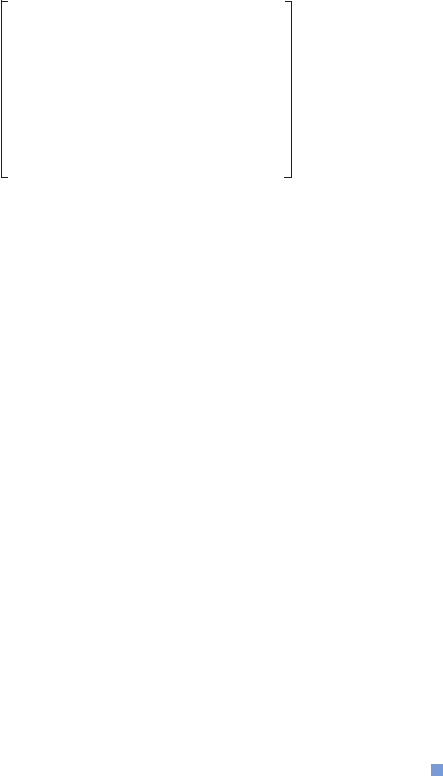
9.4 GAME THEORY AND STRICTLY DETERMINED GAMES 513
To facilitate the analysis of the problem, we represent the given data in the form
of a matrix called a payoff matrix:
C ’s moves
Heads Tails
R’s moves
Each row of the matrix corresponds to one of the two possible moves by Richie
(referred to as the row player, R), whereas each column corresponds to one of the two
possible moves by Chuck (referred to as the column player, C). Each entry in the
matrix represents the payoff from C to R. For example, the entry a
11
3 represents a
$3 payoff from Chuck to Richie (C to R) when Richie chooses to play row
1 (heads) and Chuck chooses to play column 1 (heads). On the other hand, the entry
a
12
6 represents (because it’s negative) a $6 payoff to C (from R) when R chooses
to play row 1 (heads) and C chooses to play column 2 (tails). (Interpret the meaning
of a
21
2 and a
22
1 for yourself.)
More generally, suppose we are given a two-person game with two players R and
C. Furthermore, suppose that R has m possible moves R
1
, R
2
, . . . , R
m
and that C has
n possible moves C
1
, C
2
, . . . , C
n
. Then, we can represent the game in terms of an
m n matrix in which each row of the matrix represents one of the m possible moves
of R and each column of the matrix represents one of the n possible moves of C:
C’s moves
C
1
C
2
. . .
C
j
. . .
C
n
R
1
a
11
a
12
. . .
a
1j
. . .
a
1n
R
2
a
21
a
22
. . .
a
2j
. . .
a
2n
. .. . .
. .. . .
. .. . .
R’s moves
R
i
a
i1
a
i2
. . .
a
ij
. . .
a
in
. .. . .
. .. . .
. .. . .
R
m
a
m1
a
m2
. . .
a
mj
. . .
a
mn
The entry a
ij
in the ith row and jth column of the (payoff) matrix represents the payoff
to R when R chooses move R
i
and C chooses move C
j
. In this context, note that a pay-
off to R means, in actuality, a payoff to C in the event that the value of a
ij
is negative.
EXAMPLE 2
The payoff matrix associated with a game is given by
C ’s moves
C
1
C
2
C
3
R’s moves
Give an interpretation of this payoff matrix.
Solution
In this two-person game, player R has two possible moves, whereas
player C has three possible moves. The payoffs are determined as follows: If R
chooses R
1
, then
R wins 1 unit if C chooses C
1
.
R loses 2 units if C chooses C
2
.
R wins 3 units if C chooses C
3
.
If R chooses R
2
, then
R wins 4 units if C chooses C
1
.
R loses 5 units if C chooses C
2
.
R loses 1 unit if C chooses C
3
.
c
1 23
4 5 1
d
R
1
R
2
c
3 6
21
d
Heads
Tails
87533_09_ch9_p483-536 1/30/08 10:12 AM Page 513

514 9 MARKOV CHAINS AND THE THEORY OF GAMES
Optimal Strategies
Let’s return to the payoff matrix of Example 1 and see how it may be used to help us
determine the “best” strategy for each of the two players R and C. For convenience,
this matrix is reproduced here:
C ’s moves
C
1
C
2
R’s moves
Let’s first consider the game from R’s point of view. Since the entries in the payoff
matrix represent payoffs to him, his initial reaction might be to seek out the largest
entry in the matrix and consider the row containing such an entry as a possible move.
Thus, he is led to the consideration of R
1
as a possible move.
Let’s examine this choice a little more closely. To be sure, R would realize the
largest possible payoff to himself ($3) if C chose C
1
; but if C chose C
2
, then R would
lose $6! Since R does not know beforehand what C’s move will be, a more prudent
approach on his part would be to assume that no matter what row he chooses, C will
counter with a move (column) that will result in the smallest payoff to him. To maxi-
mize the payoff to himself under these circumstances, R would then select from
among the moves (rows) the one in which the smallest payoff is as large as possible.
This strategy for R, called, for obvious reasons, the maximin strategy, may be sum-
marized as follows:
For the problem under consideration, we can organize our work as follows:
Row
minima
6
1 씯 Larger of the row minima
From these results, it is seen that R’s “best” move is row 2. By choosing this move R
stands to win at least $1.
Next, let’s consider the game from C’s point of view. His objective is to minimize
the payoff to R. This is accomplished by choosing the column whose largest payoff is
as small as possible. This strategy for C, called the minimax strategy, may be sum-
marized as follows:
Minimax Strategy
1. For each column of the payoff matrix, find the largest entry in that column.
2. Choose the column for which the entry found in step 1 is as small as possi-
ble. This column constitutes C’s “best” move.
c
3 6
21
d
Maximin Strategy
1. For each row of the payoff matrix, find the smallest entry in that row.
2. Choose the row for which the entry found in step 1 is as large as possible.
This row constitutes R’s “best” move.
c
3 6
21
d
R
1
R
2
87533_09_ch9_p483-536 1/30/08 10:12 AM Page 514

9.4 GAME THEORY AND STRICTLY DETERMINED GAMES 515
We can organize the work involved in determining C’s “best” move as follows:
Column maxima 3 1
앖
Smaller of the column maxima
From these results, we see that C’s “best” move is column 2. By choosing this move,
C stands to lose at most $1.
EXAMPLE 3
For the game with the following payoff matrix, determine the max-
imin and minimax strategies for each player.
Solution
We determine the minimum of each row and the maximum of each col-
umn of the payoff matrix and then display these numbers by circling the largest of
the row minima and the smallest of the column maxima:
Row
minima
3
2
1 씯 Largest of the row minima
Column maxima 6 0 4
앖
Smallest of the column maxima
From these results, we conclude that the maximin strategy (for the row player) is
to play row 3, whereas the minimax strategy (for the column player) is to play col-
umn 2.
EXAMPLE 4
Determine the maximin and minimax strategies for each player in a
game whose payoff matrix is given by
Solution
Proceeding as in the last example, we obtain the following:
Row
minima
4
3 씯 Larger of the row minima
Column maxima 3 4 3
앖
Smallest of the column maxima
from which we conclude that the maximin strategy for the row player is to play
row 2, whereas the minimax strategy for the column player is to play column 3.
In arriving at the maximin and minimax strategies for the respective players, we
have assumed that both players always act rationally, with the knowledge that their
opponents will always act rationally. This means that each player adopts a strategy of
always making the same move and assumes that his opponent is always going to
c
344
2 1 3
d
c
344
2 1 3
d
£
3 24
203
6 11
§
£
3 24
203
6 11
§
c
3 6
21
d
87533_09_ch9_p483-536 1/30/08 10:12 AM Page 515

516 9 MARKOV CHAINS AND THE THEORY OF GAMES
counter that move with a move that will maximize the payoff to the opponent. Thus,
each player adopts the pure strategy of always making the move that will minimize the
payoff his opponent can receive and thereby maximize the payoff to himself.
This raises the following question: Suppose a game is played repeatedly and one
of the players realizes that the opponent is employing his maximin (or minimax) strat-
egy. Can this knowledge be used to the player’s advantage? To obtain a partial answer
to this question, let’s consider the game posed in Example 3. There, the minimax strat-
egy for the column player is to play column 2. Suppose, in repeated plays of the game,
a player consistently plays that column and this strategy becomes known to the row
player. The row player may then change the strategy from playing row 3 (the maximin
strategy) to playing row 2, thereby reducing losses from 1 unit to zero. Thus, at least
for this game, the knowledge that a player is employing the maximin or minimax strat-
egy can be used to the opponent’s advantage.
There is, however, a class of games in which the knowledge that a player is using
the maximin (or minimax) strategy proves of no help to the opponent. Consider the
game of Example 4. There, the row player’s maximin strategy is to play row 2, and
the column player’s minimax strategy is to play column 3. Suppose, in repeated plays
of the game, R (the row player) has discovered that C (the column player) consis-
tently chooses to play column 3 (the minimax strategy). Can this knowledge be used
to R’s advantage? Now, other than playing row 2 (the maximin strategy), R may
choose to play row 1. But if R makes this choice, then he would lose 4 units instead
of 3 units! Clearly, in this case, the knowledge that C is using the minimax strategy
cannot be used to advantage. R’s optimal (best) strategy is the maximin strategy.
Next, suppose that in repeated plays of the game, C has discovered that R consis-
tently plays row 2 (his optimal strategy). Can this knowledge be used to C’s advan-
tage? Another glance at the payoff matrix reveals that by playing column 1, C stands
to lose 2 units, and by playing column 2, he stands to win 1 unit, as compared with
winning 3 units by playing column 3, as called for by the minimax strategy. Thus, as
in the case of R, C does not benefit from knowing his opponent’s move. Furthermore,
his optimal strategy coincides with the minimax strategy.
This game, in which the row player cannot benefit from knowing that his or her
opponent is using the minimax strategy and the column player cannot benefit from
knowing that his or her opponent is using the maximin strategy, is said to be strictly
determined.
Strictly Determined Game
A strictly determined game is characterized by the following properties:
1. There is an entry in the payoff matrix that is simultaneously the smallest entry
in its row and the largest entry in its column. This entry is called the
saddle
point
for the game.
2. The optimal strategy for the row player is the maximin strategy, obtained by
choosing the row containing the saddle point. The optimal strategy for the
column player is the minimax strategy, obtained by choosing the column con-
taining the saddle point.
Optimal Strategy
The optimal strategy in a game is the strategy that is most profitable to a par-
ticular player.
87533_09_ch9_p483-536 1/30/08 10:12 AM Page 516

The saddle point of a strictly determined game is also referred to as the value of
the game. If the value of a strictly determined game is positive, then the game favors
the row player. If the value is negative, it favors the column player. If the value of the
game is zero, the game is called a fair game.
Returning to the coin-matching game discussed earlier, we conclude that Richie’s
optimal strategy consists of playing row 2 repeatedly, whereas Chuck’s optimal strat-
egy consists of playing column 2 repeatedly. Furthermore, the value of the game is 1,
implying that the game favors the row player, Richie.
EXAMPLE 5
A two-person, zero-sum game is defined by the payoff matrix
A
a. Show that the game is strictly determined and find the saddle point(s) for the
game.
b. What is the optimal strategy for each player?
c. What is the value of the game? Does the game favor one player over the other?
Solution
a. First, we determine the minimum of each row and the maximum of each column
of the payoff matrix A and display these minima and maxima as follows:
Row
minima
3
2 씯 Largest of the row minima
4
Column maxima 2 3 2
앖
Smallest of the column maxima
From these results, we see that the circled entry, 2, is simultaneously the small-
est entry in its row and the largest entry in its column. Therefore, the game is
strictly determined, with the entry a
23
2 as its saddle point.
b. From these results, we see that the optimal strategy for the row player is to make
the move represented by the second row of the matrix, and the optimal strategy
for the column player is to make the move represented by the third column.
c. The value of the game is 2, which implies that if both players adopt their best
strategy, the column player will win 2 units in a play. Consequently, the game
favors the column player.
A game may have more than one saddle point, as the next example shows.
EXAMPLE 6
A two-person, zero-sum game is defined by the payoff matrix
A
a. Show that the game is strictly determined and find the saddle points for the
game.
b. Discuss the optimal strategies for the players.
c. Does the game favor one player over the other?
£
454
2 5 3
468
§
£
123
122
234
§
£
123
122
234
§
9.4 GAME THEORY AND STRICTLY DETERMINED GAMES 517
87533_09_ch9_p483-536 1/30/08 10:12 AM Page 517
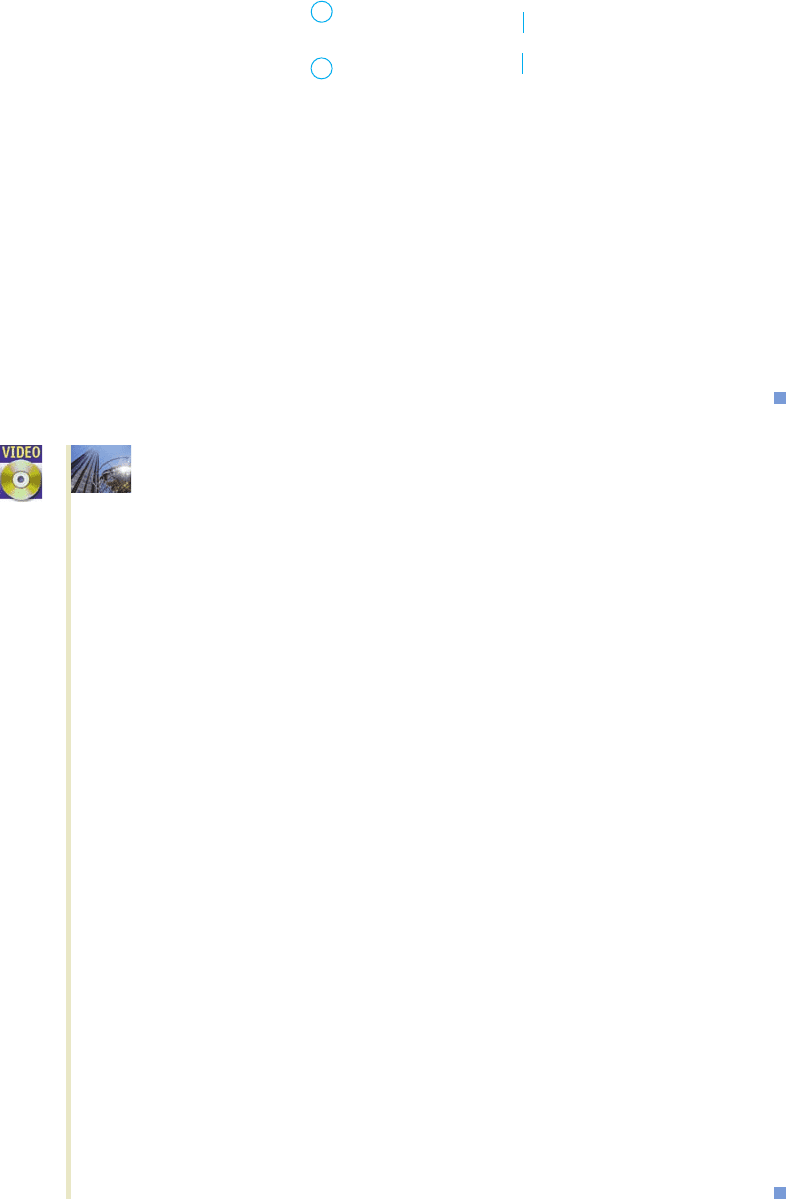
518 9 MARKOV CHAINS AND THE THEORY OF GAMES
Solution
a. Proceeding as in the previous example, we obtain the following information:
Row
minima
4
5 Largest of the row minima
4
Column maxima 4 6 8
앖
Smallest of the column maxima
We see that each of the circled entries, 4, is simultaneously the smallest entry in
the row and the largest entry in the column containing it. Therefore, the game is
strictly determined, and in this case it has two saddle points: the entry a
11
4
and the entry a
31
4. In general, it can be shown that every saddle point of a
payoff matrix must have the same value.
b. Since the game has two saddle points, both lying in the first column and in the
first and third rows of the payoff matrix, we see that the row player’s optimal
strategy consists of playing either row 1 or row 3 consistently, whereas the col-
umn player’s optimal strategy consists of playing column 1 repeatedly.
c. The value of the game is 4, which implies that it favors the row player.
APPLIED EXAMPLE 7
Bidding for Rights Two television subscrip-
tion companies, UBS and Telerama, are planning to extend their operations
to a certain city. Each has the option of making its services available to prospec-
tive subscribers with a special introductory subscription rate. It is estimated that if
both UBS and Telerama offer the special subscription rate, each will get 50% of
the market, whereas if UBS offers the special subscription rate and Telerama
does not, UBS will get 70% of the market. If Telerama offers the special sub-
scription rate and UBS does not, it is estimated that UBS will get 40% of the
market. If both companies elect not to offer the special subscription rate, it is
estimated that UBS will get 60% of the market.
a. Construct the payoff matrix for the game.
b. Show that the game is strictly determined.
c. Determine the optimal strategy for each company and find the value of the
game.
Solution
a. The required payoff matrix is given by
Telerama
Intro. Usual
rate rate
UBS
b. The entry a
11
.50 is the smaller entry in its row and the larger entry in its
column. Therefore, the entry a
11
.50 is a saddle point of the game and the
game is strictly determined.
c. The entry a
11
.50 is the only saddle point of the game, so UBS’s optimal
strategy is to choose row 1, and Telerama’s optimal strategy is to choose col-
umn 1. In other words, both companies should offer their potential customers
their respective introductory subscription rates.
c
.50 .70
.40 .60
d
Intro. rate
Usual rate
£
454
2 5 3
468
§
씯
—
씯
—
87533_09_ch9_p483-536 1/30/08 10:12 AM Page 518
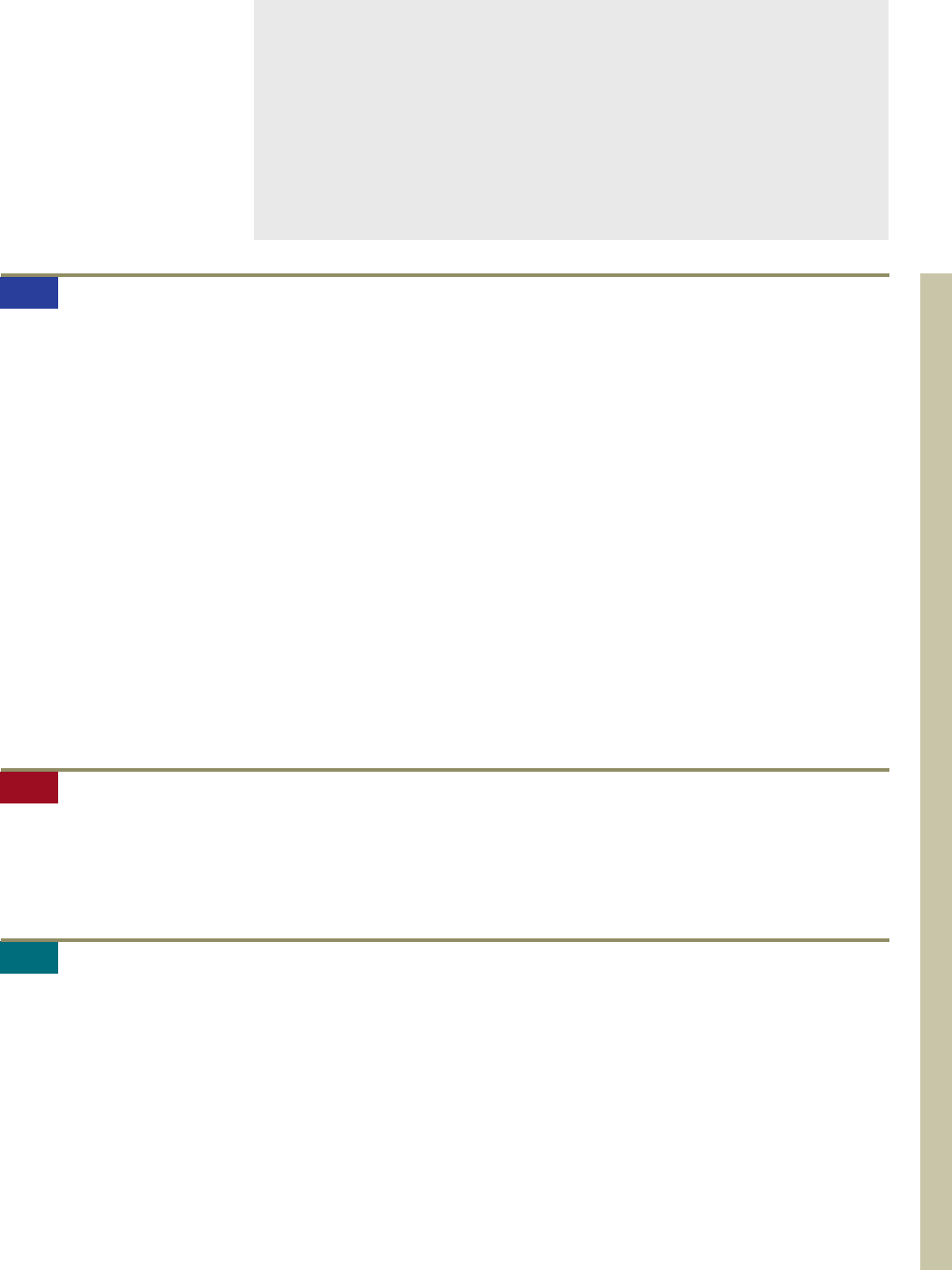
1. A two-person, zero-sum game is defined by the payoff
matrix
A
a. Show that the game is strictly determined and find the
saddle point(s) for the game.
b. What is the optimal strategy for each player?
c. What is the value of the game? Does the game favor one
player over the other?
2. The management of Delta Corporation, a construction and
development company, is deciding whether to go ahead
with the construction of a large condominium complex. A
financial analysis of the project indicates that if Delta goes
ahead with the development and the home mortgage rate
drops 1 point or more by next year, when the complex is
expected to be completed, it will stand to make a profit of
$750,000. If Delta goes ahead with the development and
the mortgage rate stays within 1 point of the current rate by
£
213
322
2 14
§
9.4 GAME THEORY AND STRICTLY DETERMINED GAMES 519
Explore & Discuss
A two-person, zero-sum game is defined by the payoff matrix
A
1. Show that the game is strictly determined.
2. What can you say about the game with the following payoff matrix?
B
c
ab
cc
d
c
aa
cd
d
9.4 Self-Check Exercises
9.4 Concept Questions
next year, it will stand to make a profit of $600,000. If
Delta goes ahead with the development and the mortgage
rate increases 1 point or more by next year, it will stand to
make a profit of $350,000. If Delta does not go ahead with
the development and the mortgage rate drops 1 point or
more by next year, it will stand to make a profit of
$400,000. If Delta does not go ahead with the development
and the mortgage rate stays within 1 point of the current
rate by next year, it will stand to make a profit of $350,000.
Finally, if Delta does not go ahead with the development
and the mortgage rate increases 1 point or more by next
year, it stands to make $250,000.
a. Represent this information in the form of a payoff
matrix.
b. Assuming that the home mortgage rate trend is volatile
over the next year, determine whether or not Delta
should go ahead with the project.
Solutions to Self-Check Exercises 9.4 can be found on
page 521.
1. a. What is the maximin strategy for the row player in a
two-person game that is represented by a payoff matrix?
b. What is the minimax strategy for the column player in a
two-person game that is represented by a payoff matrix?
2. a. How do you find the saddle point in the payoff matrix
for a strictly determined game?
b. What is the optimal strategy for the row player in a
strictly determined game? The column player?
9.4 Exercises
In Exercises 1–8, determine the maximin and minimax
strategies for each two-person, zero-sum matrix game.
1. 2.
3. 4. c
142
463
dc
132
0 14
d
c
13
25
dc
23
41
d
5. 6.
7. 8. ≥
11 2
31 1
11 2
321
¥£
42 1
101
21 3
§
£
14
2 2
30
§£
321
1 23
641
§
87533_09_ch9_p483-536 1/30/08 10:12 AM Page 519

520 9 MARKOV CHAINS AND THE THEORY OF GAMES
In Exercises 9–18, determine whether the two-person,
zero-sum matrix game is strictly determined. If a game is
strictly determined,
a. Find the saddle point(s) of the game.
b. Find the optimal strategy for each player.
c. Find the value of the game.
d. Determine whether the game favors one player over
the other.
9. 10.
11. 12.
13. 14.
15. 16.
17. 18.
19. Robin and Cathy play a game of matching fingers. On a
predetermined signal, both players simultaneously extend
1, 2, or 3 fingers from a closed fist. If the sum of the num-
ber of fingers extended is even, then Robin receives an
amount in dollars equal to that sum from Cathy. If the sum
of the number of fingers extended is odd, then Cathy
receives an amount in dollars equal to that sum from
Robin.
a. Construct the payoff matrix for the game.
b. Find the maximin and the minimax strategies for Robin
and Cathy, respectively.
c. Is the game strictly determined?
d. If the answer to part (c) is yes, what is the value of the
game?
20. M
ANAGEMENT
D
ECISIONS
Brady’s, a conventional depart-
ment store, and ValueMart, a discount department store,
are each considering opening new stores at one of two pos-
sible sites: the Civic Center and North Shore Plaza. The
strategies available to the management of each store are
given in the following payoff matrix, where each entry rep-
resents the amounts (in hundreds of thousands of dollars)
either gained or lost by one business from or to the other as
a result of the sites selected.
ValueMart
Center Plaza
Brady’s
Civic Center
North Shore Plaza
c
2 ⫺2
3 ⫺4
d
≥
3 ⫺10⫺4
2102
⫺31⫺21
⫺1 ⫺1 ⫺21
¥£
1 ⫺13 2
1022
⫺223⫺1
§
≥
⫺12 4
23 5
01⫺3
⫺24⫺2
¥≥
12
03
⫺12
2 ⫺2
¥
£
242
030
⫺1 ⫺21
§£
1342
026⫺4
⫺1 ⫺3 ⫺21
§
£
32
⫺1 ⫺2
41
§c
13 2
⫺14⫺6
d
c
10
0 ⫺1
dc
23
1 ⫺4
d
a. Show that the game is strictly determined.
b. What is the value of the game?
c.
Determine the best strategy for the management of each
store (that is, determine the ideal locations for each
store).
21. F
INANCIAL
A
NALYSIS
The management of Acrosonic is
faced with the problem of deciding whether to expand the
production of its line of electrostatic loudspeaker systems.
It has been estimated that an expansion will result in an an-
nual profit of $200,000 for Acrosonic if the general eco-
nomic climate is good. On the other hand, an expansion
during a period of economic recession will cut its annual
profit to $120,000. As an alternative, Acrosonic may hold
the production of its electrostatic loudspeaker systems at
the current level and expand its line of conventional loud-
speaker systems. In this event, the company will make a
profit of $50,000 in an expanding economy (because many
potential customers will be expected to buy electrostatic
loudspeaker systems from other competitors) and a profit
of $150,000 in a recessionary economy.
a. Construct the payoff matrix for this game.
Hint: The row player is the management of the company and the
column player is the economy.
b. Should management recommend expanding the com-
pany’s line of electrostatic loudspeaker systems?
22. F
INANCIAL
A
NALYSIS
The proprietor of Belvedere’s is faced
with the problem of deciding whether to expand his restau-
rant facilities now or to wait until some future date to do
so. If he expands the facilities now and the economy expe-
riences a period of growth during the coming year, he will
make a net profit of $442,000; if he expands now and a
period of zero growth follows, then he will make a net
profit of $40,000; and if he expands now and an economic
recession follows, he will suffer a net loss of $108,000. If
he does not expand the restaurant now and the economy
experiences a period of growth during the coming year, he
will make a net profit of $280,000; if he does not expand
now and a period of zero growth follows, he will make a
net profit of $190,000. Finally, if he does not expand now
and an economic recession follows, he will make a net
profit of $100,000.
a. Represent this information in the form of a payoff
matrix.
b. Determine whether the owner of the restaurant should
expand his facilities at this time.
23. M
ARKET
S
HARE
Roland’s Barber Shop and Charley’s Bar-
ber Shop are both located in the business district of a cer-
tain town. Roland estimates that if he raises the price of a
haircut by $1, he will increase his market share by 3% if
Charley raises his price by the same amount; he will
decrease his market share by 1% if Charley holds his price
at the same level; and he will decrease his market share by
3% if Charley lowers his price by $1. If Roland keeps his
price the same, he will increase his market share by 2% if
Charley raises his price by $1; he will keep the same mar-
ket share if Charley holds the price at the same level; and
87533_09_ch9_p483-536 2/18/08 10:48 AM Page 520
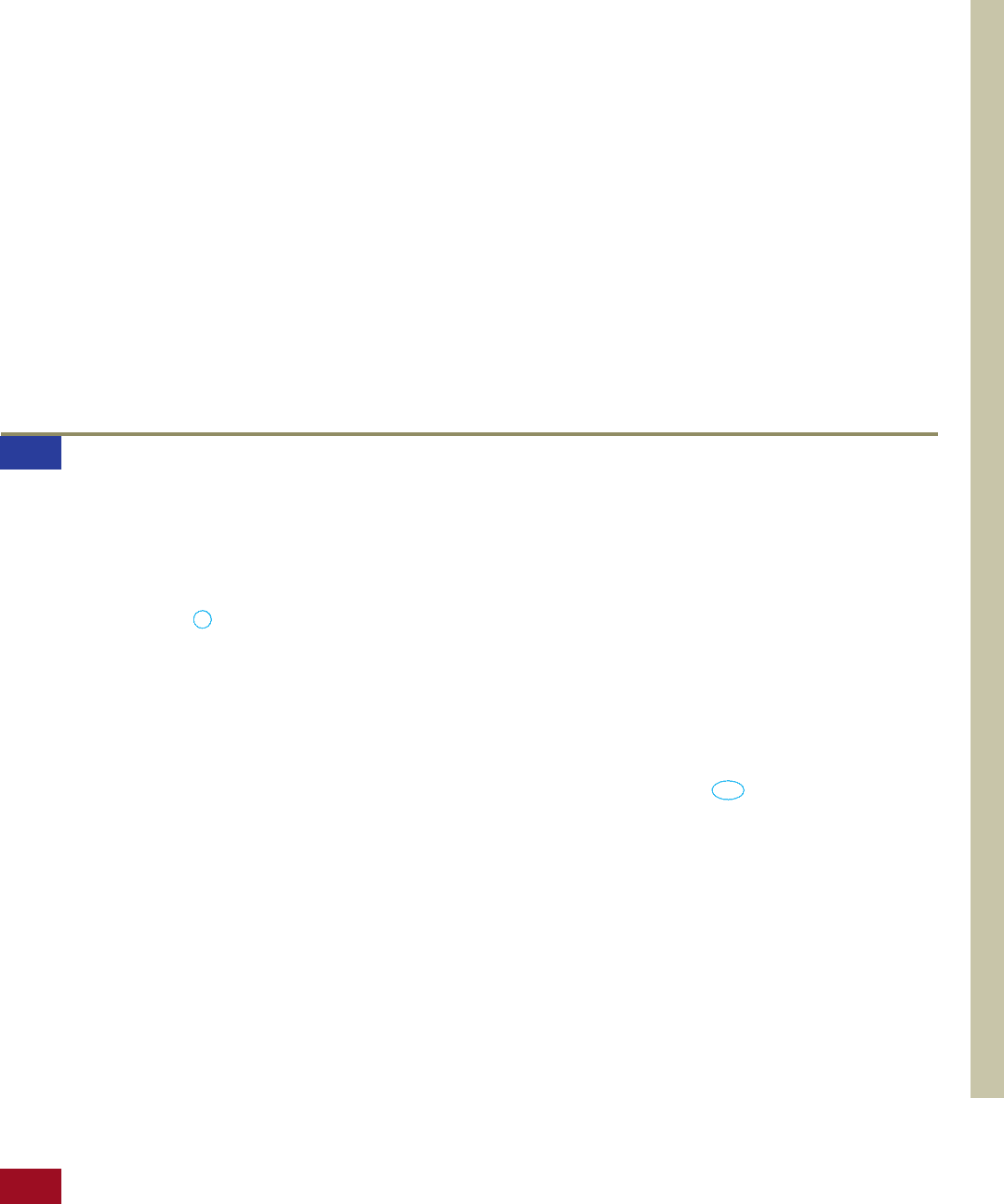
9.5 GAMES WITH MIXED STRATEGIES 521
he will decrease his market share by 2% if Charley lowers
his price by $1. Finally, if Roland lowers the price he
charges by $1, his market share will increase by 5% if
Charley raises his prices by the same amount; he will
increase his market share by 2% if Charley holds his price
at the same level; and he will increase his market share by
1% if Charley lowers his price by $1.
a. Construct the payoff matrix for this game.
b. Show that the game is strictly determined.
c. If neither party is willing to lower the price he charges
for a haircut, show that both should keep their present
price structures.
In Exercises 24–26, determine whether the statement is
true or false. If it is true, explain why it is true. If it is
false, give an example to show why it is false.
24. In a zero-sum game, the payments made by the players at
the end of each play add up to zero.
25. In a strictly determined game, the value of the game is
given by the saddle point of the game.
26. If the value of a strictly determined game is not negative, it
favors the row player.
9.4 Solutions to Self-Check Exercises
1. a. Displaying the minimum of each row and the maximum
of each column of the payoff matrix A, we obtain
Row
minima
2
2 씯
1
Column maxima 3 2 4
앖
Smallest of the column maxima
From these results, we see that the circled entry, 2, is
simultaneously the smallest entry in its row and the
largest entry in its column. Therefore, the game is
strictly determined, with the entry a
22
2 as its saddle
point.
b. From these results, we see that the optimal strategy for
the row player is to make the move represented by the
second row of the matrix, and the optimal strategy for
the column player is to make the move represented by
the second column.
c. The value of the game is 2, which implies that if both
players adopt their best strategy, the row player will win
2 units in a play. Consequently, the game favors the row
player.
2. a. We may review this situation as a game in which the
row player is Delta and the column player is the home
mortgage rate. The required payoff matrix is
£
213
322
2 14
§
Largest of the
row minima
Mortgage rate
Decrease Steady Increase
Delta Project
Corp. No project
(All figures are in thousands of dollars.)
b. From part (a), the payoff matrix under consideration is
Proceeding in the usual manner, we find
Row
minima
350 씯
250
Column maxima 750 600 350
앖
Smallest of the column maxima
From these results, we see that the entry a
13
350 is a
saddle point and the game is strictly determined. We
can also conclude that the company should go ahead
with the project.
c
750 600 350
400 350 250
d
Largest of the
row minima
c
750 600 350
400 350 250
d
c
750 600 350
400 350 250
d
9.5 Games with Mixed Strategies
In Section 9.4, we discussed strictly determined games and found that the optimal
strategy for the row player is to select the row containing a saddle point for the game,
and the optimal strategy for the column player is to select the column containing a sad-
dle point. Furthermore, in repeated plays of the game, each player’s optimal strategy
consists of making the same move over and over again, since the discovery of the
87533_09_ch9_p483-536 1/30/08 10:12 AM Page 521
